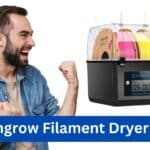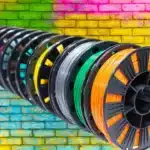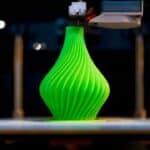
Creating home decor with a 3D printer opens up endless opportunities for customization, creativity, and convenience. Yet, with so many types of filament on the market, it can be tricky to know which one is right for a specific decor project. Not all filaments are equally suited to every decor item; some are better for aesthetic pieces, while others hold up to moisture or heavy use. In this guide, we’ll dive into everything you need to know about choosing the best 3D printing filament for home decor, from understanding filament types to selecting materials based on durability, aesthetics, ease of printing, and more. By the end, you’ll feel confident in picking the perfect filament for your next home decor project!
Understanding the Basics of 3D Printing Filament
Affiliate Disclosure
We participate in Amazon affiliate programs, earning fees from qualifying purchases via links at no extra cost to you. It’s how we keep this blog rolling and my 3D printers buzzing with fresh filament for reviews like this one!
At its core, filament is the material fed into your 3D printer to create objects layer by layer. The type of filament you choose will directly affect the look, feel, and durability of your decor items. Filament types are typically distinguished by material—such as PLA (Polylactic Acid), ABS (Acrylonitrile Butadiene Styrene), and PETG (Polyethylene Terephthalate Glycol)—with each offering unique properties. Specialty filaments, like wood-fill and metal-fill, bring in exciting possibilities for custom decor designs with their added textures. Understanding these materials can help you decide which filament best meets the specific needs of your decor project.
Key Factors to Consider When Choosing Filament for Home Decor
Choosing filament for decor involves balancing aesthetics, durability, ease of printing, and environmental considerations. Here’s how these factors impact the quality and usability of your 3D printed decor pieces:
1. Aesthetic Appeal
The aesthetic of a decor piece is often a top priority, especially if it will be displayed in a prominent area. Each filament type offers a different look: PLA provides a smooth, glossy finish, ideal for modern, polished items, while wood-fill filaments lend a warm, rustic appearance that’s great for natural or farmhouse-inspired designs. You may also find silk PLA, which adds a metallic sheen to decorative items, perfect for adding a bit of flair. Think about the overall vibe of your space and the specific style of each decor item to decide on the right aesthetic qualities for your filament.
2. Durability and Strength
If you’re creating decor that needs to be functional—like wall hooks or plant pots—choosing a durable filament is essential. PETG, for instance, is a strong, flexible material that holds up well to wear and tear and is resistant to moisture, making it ideal for bathroom decor, planters, or items exposed to humidity. ABS is another option known for its strength and ability to withstand temperature fluctuations, although it can be trickier to print with than PLA or PETG. For items intended to be purely decorative, durability may be less important, giving you the flexibility to use materials like PLA, which is easier to print but less durable.
3. Ease of Printing and Post-Processing
If you’re new to 3D printing or want a straightforward project, start with filaments that are easier to print, like PLA. PLA prints well at lower temperatures and does not require a heated bed, making it ideal for beginner printers or quick decor projects. ABS, on the other hand, can be challenging to print because it requires stable temperatures to avoid warping, but it’s worth the effort for items that need more resilience. Post-processing, such as sanding and painting, can also affect your choice—some materials are easier to work with than others after printing, so consider if your project will need any finishing touches.
4. Environmental and Safety Considerations
Some filaments are better suited to indoor use than others, especially if they release fumes during printing. PLA is a biodegradable material made from renewable resources, which makes it an eco-friendly choice for indoor decor. For outdoor decor or pieces that may encounter moisture, PETG is an excellent choice since it’s resistant to humidity and highly durable. If you’re concerned about indoor air quality, it’s best to avoid filaments like ABS, which can release harmful fumes, unless you have a well-ventilated workspace.
Popular Filament Types for 3D Printed Home Decor
Each filament type brings its unique strengths and limitations to home decor. Here’s a look at some of the most popular choices and when to use each.
PLA (Polylactic Acid)
PLA is one of the most widely used filaments for 3D printing, thanks to its ease of use, affordability, and eco-friendly properties. It’s perfect for indoor decorative pieces that won’t experience heavy handling or high temperatures. For example, if you’re printing a vase, photo frame, or small figurine, PLA offers a smooth, attractive finish and is easy to work with. However, it is sensitive to heat, so avoid placing PLA items near heat sources or in direct sunlight, as this may cause warping.
ABS (Acrylonitrile Butadiene Styrene)
ABS is more durable than PLA and can withstand higher temperatures, making it a good choice for functional items or decor in more active spaces. It’s especially useful for objects like desk organizers or wall hooks that may need to bear some weight. However, ABS can release fumes while printing, so it’s best to use this filament in a well-ventilated area. Keep in mind that ABS is less beginner-friendly than PLA, but the added durability can be worth the extra effort if you need items that last.
PETG (Polyethylene Terephthalate Glycol)
PETG combines some of the best properties of both PLA and ABS. It’s strong, flexible, and moisture-resistant, making it a good option for planters, bathroom decor, and outdoor items. PETG’s moisture resistance means it won’t warp or deteriorate when exposed to water, and it’s easy to post-process for a smooth, polished look. While PETG can be a bit trickier to print than PLA, it’s not as demanding as ABS, striking a nice balance for decor that requires durability without too much hassle.
Specialty Filaments (Wood-Filled, Metal-Filled, Silk PLA)
Specialty filaments add unique textures and finishes to your decor projects. Wood-filled filaments, for instance, give items a natural, wooden texture, making them perfect for rustic or farmhouse-style pieces. Metal-filled filaments can create decor that looks metallic without the weight of real metal, while silk PLA offers a shiny, smooth finish ideal for display pieces. Specialty filaments are best for decor pieces that aren’t subjected to rough handling, as they’re typically more delicate and may require specific print settings.
Additional Tips for Choosing the Right Filament Based on Decor Type
Not all decor items have the same requirements, so here are some tips for choosing filaments based on the type of item you’re creating.
Filaments for Indoor Decorative Items
For items that will stay indoors and are primarily decorative, PLA and silk PLA are excellent options. They’re affordable, easy to print, and come in a range of colors and finishes. Vases, picture frames, and wall art are great projects for PLA, as these items don’t need to withstand much stress or temperature variation.
Filaments for Functional Decor (e.g., Planters, Hooks, Organizers)
For functional items that need durability, PETG and ABS are better choices. PETG’s flexibility and resistance to water make it great for planters and bathroom decor, while ABS’s strength is useful for wall hooks or organizers. Both materials offer added durability that can keep your functional decor in good condition for longer.
Filament Finishing Techniques for Enhanced Home Decor
Certain finishing techniques can elevate the look of your 3D printed decor. Here are some techniques that work well with different filament types:
Painting and Sanding
For a smoother, custom finish, you can sand and paint your 3D prints. PLA is relatively easy to sand and paint, making it ideal for colorful decor. With a bit of sanding, ABS can also achieve a polished look, especially when smoothed with acetone vapor.
Polishing with Acetone (for ABS)
ABS prints can be smoothed out with acetone vapor to achieve a glossy, polished surface. This technique is especially useful for making sleek, professional-looking decor items. However, acetone vapor treatment requires safety precautions, so make sure to use it in a well-ventilated area.
Varnishing for Added Protection
Applying a clear varnish to wood-fill or metal-fill prints can protect them from scratches and add a beautiful finish. This extra step is great for enhancing the durability of decor items while highlighting their natural beauty.
Filament Buying Guide – Where and How to Choose Quality Filaments
Choosing quality filament can make a big difference in the final look and strength of your decor. Opting for reputable brands like Hatchbox, eSUN, and Prusament can ensure that you’re getting consistent results, as these brands are known for quality control. Trusted online stores such as Amazon, MatterHackers, and 3D printing specialty shops offer various filament options, allowing you to compare prices, colors, and properties. Checking for authentic brands and reading reviews can also be helpful in choosing filaments that meet your standards.
Conclusion
Choosing the right filament for 3D printed home decor involves balancing factors like aesthetic appeal, durability, ease of printing, and environmental impact. Whether you’re a beginner looking to make simple indoor decor with PLA or an experienced printer aiming to create durable planters and hooks with PETG or ABS, understanding the unique qualities of each filament type can help you make the best choice. So dive in, experiment with different materials, and enjoy creating beautiful, customized decor pieces for.your home!
Frequently Asked Questions (FAQs)
What is the best 3D printing filament for beginners?
PLA (Polylactic Acid) is often recommended for beginners due to its ease of use, low printing temperature, and minimal odor.
Which filament is best for strong and durable prints?
ABS (Acrylonitrile Butadiene Styrene) is a popular choice for strong and durable prints, but it requires a higher printing temperature and an enclosed printer to prevent warping.
What filament is best for flexible prints?
TPU (Thermoplastic Polyurethane) is a flexible filament that can be used to create a variety of flexible objects, such as phone cases and gaskets.
What is the best filament for detailed prints?
PETG (Polyethylene Terephthalate Glycol) is a good option for detailed prints as it has good layer adhesion and dimensional accuracy.
How do I choose the right filament for my project?
Consider the following factors when choosing a filament: the desired properties of the final print (strength, flexibility, heat resistance, etc.), the type of 3D printer you have, and the specific application of the print.













